#romani in Austria
Explore tagged Tumblr posts
Text

Ceija Stojka, Roma at Grape Harvest, no date. Collection Michaela Grobbel
2 notes
·
View notes
Text

Ceija Stojka with her mother
17 notes
·
View notes
Photo
kinda evil how some corporation exists so ubiquitously that its all over europe
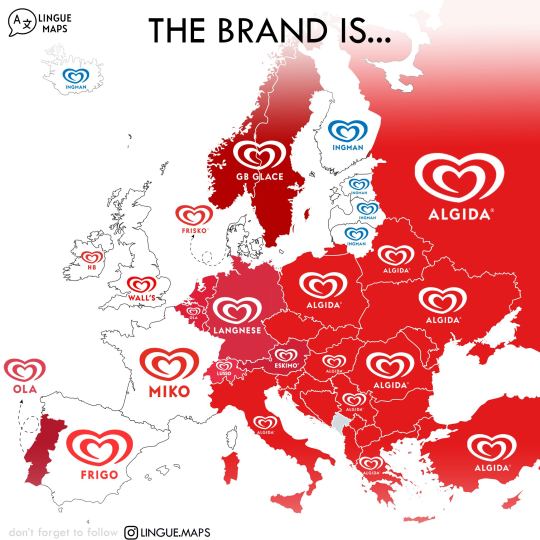
This post shows how this famous logo is called in various countries.
by lingue.maps
#also austria having a casual slur moment™️ 😬#sweetie we don’t use that word#then again this is the continent that calls the Romani by the g slur so what do they care about political correctness
258 notes
·
View notes
Text
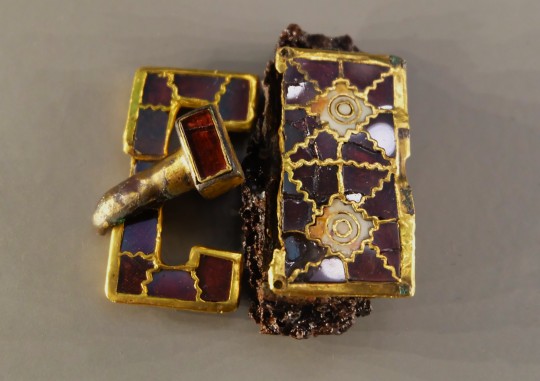
Belt Buckle from Maria Ponsee, Austria dated between 500 - 800 CE on display at the Kunsthistorisches Museum in Vienna, Austria
With almost 100 graves, Maria Ponsee is the largest Langobardian burial site in Austria. It was excavated in 1965 and 1966 by the Federal Monuments Office and is one of the few cemeteries from this period to have been completely examined. Three ethnic groups buried their deceased here: Langobards, Thuringii and Romani or Suebi. What remains in these graves is what was left by grave robbers over the centuries.
Photographs taken by myself 2022
#art#archaeology#history#fashion#austria#austrian#migration period#kunsthistorisches museum#vienna#barbucomedie
228 notes
·
View notes
Text
Stoker took the assertion that Romani attach themselves to local nobleman (and could functionally serve as a "parcels-delivery company") from Andrew Crosse's Round About the Carpathians. What neither Stoker nor Crosse delve into though is that the reason Romani were ostensibly settling around local Magyar authority figures probably had to do with over a century of forced settlement/assimilation policies in Hungary (and as a slight reminder, during Dracula, Transylvania is still part of Austria-Hungary and not yet part of Romania).
After over a hundred years of being forced by various 18th century decrees to abandon one's language and numerous means of transit/moving (with things like owning horses not for sale and setting up encampments being restricted), it might seem pretty sensible to--you know--affiliate oneself with settled people in power. Basically, the Romani moved from being perceived as antisocial vagabonds to being perceived as sycophantic hangers on... which moves them right from being fodder for traditional racist fictional depictions of colorful/exotic wanderers to being fodder for racist fictional depictions of villainous henchmen.
784 notes
·
View notes
Text
Updated list of countries/cultures with Mikus on this blog :-)
Europe
Turkey
Netherlands
Romani
Hungary
Iceland
Moldova
Germany
Finland
Greece
France
Denmark
Poland
Romania
Ukraine
Hungary
Lithuania
Ireland
Wales
Belarus
Scotland
Slovakia
Italy
United Kingdom
Norway
Portugal
Kosovo
Latvia
Russia
Estonia
Slovenia
Serbia
Spain
Austria
San Marino
Mari
Czechia
Bosnia
Catalán
Croatia
Switzerland
Vatican City
Montenegro
Malta
Belgium
Asia
Jordan
Syria
Armenia
Ingush
China
Palestine
Taiwan
Tajikistan
India
Bhutan
Malaysia
Philippines
Pakistan
Thailand
Burma
Indonesia
Bangladesh
Vietnam
Nepal
Korea
Kazakhstan
Turkmenistan
Afghanistan
Kurdistan
Uzbekistan
Iran
Laos
Georgia
Cambodia
Oceania/Pacific Islands
Samoa
Fiji
Tuvalu
Maori
Aboriginal Australian
Papua New Guinea
Africa
South Sudan
Togo
Nigeria
South Africa
Algeria
Djibouti
Egypt
Ethiopia
Namibia
Ghana
Cameroon
Tunisia
Kenya
Morocco
Mozambique
Angola
Madagascar
Congo
North America
Cherokee
Guatemala
Panama
El Salvador
Mexico
Cuba
Honduras
Chicana
Trinidad
Anishinaabe
Canada
Muskogee
Belize
African American
Barbados
Yupik
Bahamas
Mi’kmaw
St. Kitts and Nevis
Jamaica
Costa Rica
Métis
Navajo
Dominica
South America
Ecuador
Peru
Argentina
Chile
Venezuela
Brazil
Colombia
Suriname
Guyana
Bolivia
Mapuche
Paraguay
Antarctica
29 notes
·
View notes
Text
It also feels so distasteful because European countries have historically forcibly sterilised women, especially the most vulnerable of European women: the poor ones and women of colour. But transactivists don't care about intersectionality, because otherwise they would talk about how poor woc have been harmed by sterilisation. That Finland example is so telling because, NO, trans people haven't been forcibly sterilised in that country. You know who has? Romani women and working class women. From 1935 to 1970. But the only kind of awareness being raised about forcible sterilisations erases them and instead focuses on white men who have never even been harmed by those politics.
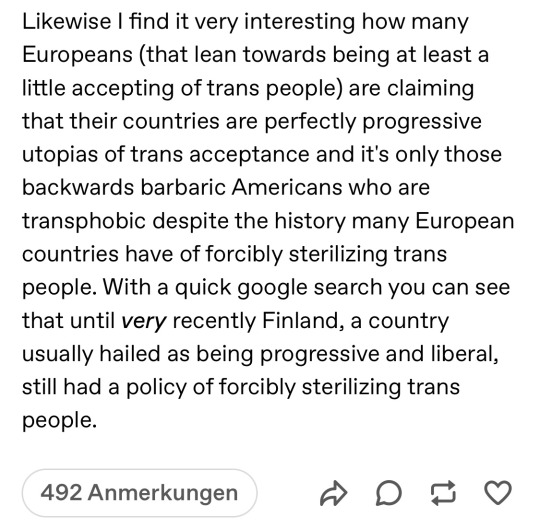
„forcibly sterilizing trans people“ actually means if you want to change your sex on your id you have to undergo sex reassignment surgery. this kind of language is a slap in the face to women in camps (for example the uighurs in china and refugees in the us) who have in fact been forcibly sterilised. smh
#forced sterilization of romani women#Finland#similar politics have also been implemented in Sweden Norway Austria Denmark France Germany Switzerland Hungary and Czechoslovakia btw#All harming working class and Romani women. But ofc white transwimmin rich enough to get surgeries have it worse somehow
348 notes
·
View notes
Note
Just how many racist misconceptions about the Roma did Lily manage to fit into one character?
I didn't look. I just saw this and I know enough about history to be frustrated to say the least:
"Valithria was born in Austria in 1935 to Lavinia Ryder. Her father's identity was unknown as was her birth name and she was raised by Lavinia and her wife Naomie. Valithria was homeschooled in her early life so her mothers could avoid revealing their relationship to others. Valithria described her mothers as kind, but is usually tight-lipped regarding any other details.
Austria was annexed by Germany in 1938 and the onset of anti-Romani propaganda caused Lavinia and Naomie to go into hiding. They were eventually discovered in 1941 when Valithria (only six years old at the time) made the mistake of greeting a soldier. Lavinia and Naomie were separated from their daughter and taken to Ravensbrück while Valithria was transported between numerous camps before finally being trapped in Auschwitz in 1942."
"Valithria spent three years in Auschwitz, constantly hiding and making ill-fated escape attempts. It is not known how exactly she survived as long as she did, as official records seized by Soviet troops stated that she was killed and she did not identify herself by her original birth name after her release.
When she was retrieved by Soviet Troops in 1945, she refused to identify herself at which point the soldier questioning her decided to call her "Valithria" in the absence of any other name to which she adopted. With her refusal to co-operate, there was no way to identify her and the Soviets handed her over to the British. Valithria finally relented and told her identity to an American woman who promised to keep everything about her secret. This woman was able to find the information about Valithria's mothers and that they'd been killed a year prior.
American Immigration and Family Life
Valithria was moved to the United States and placed into a refugee orphanage where she remained until she turned 21, then spent the next 3 years wandering the country and couch-surfing before attending a community college to study psychology.
After leaving college, Valithria adopted an orphaned girl named Tolrah and moved into a two-bedroom apartment to give the girl her own space. Several years later she adopted another girl named Ascentia and moved them into a small house. In 1976, Valithria met a young woman named Megan who was interning at her boss's practice and the two quickly became friends. Megan quickly took to the girls, though they were considerably more wary of her.
In 1977, Valithria adopted yet another girl named Sutanu.
Two years later, Valithria and Megan began seeing each other romantically. In 1984, Valithria announced to her daughters that she and Megan were getting married. While Sutanu was excited at the news, Ascentia and Tolrah openly voiced opposition, claiming that Megan was only a few years older than she was. Animosity grew between Tolrah and Megan, which resulted in Tolrah moving out and keeping contact with her family to a minimum.
In 1990, Valithria discovered Phyaun crawling around the wilderness, clearly feral. With no trace of her parents and Vital Statistics unable to trace her whereabouts, Valithria opted to take her in.
In 1991, Valithria received a call about a particularly troubled young girl named Elethyn, who had been in and out of foster care for most of her life. Seeing a bit of herself in the girl, Valithria opted to adopt her as well."
This is all Lily's own writing if you check the history.

7 notes
·
View notes
Text
What is Ukraine Anyways?
Ok so lets start, what is Ukraine? Ukraine is a nation in Eastern Europe, just south of Belarus, just East of Poland, just north of Romania and Moldova, and just West of Russia. I know what you're thinking “Belarus, what's that '' so ok, maybe US geography could use a bit of work. Before the war Ukraine had a population of 44 million people, and was either the largest or second largest nation in Europe depending on how you count Russia. And I think that is worth focusing on. Ukraine is massive, about the size of Texas, and yet it's forgotten because it's next to Russia, the largest nation in the world.
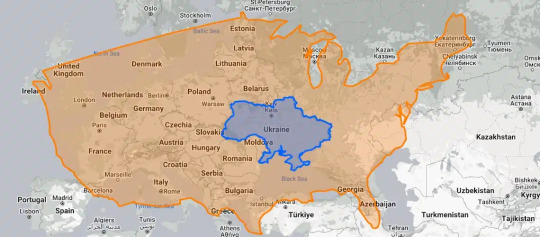
Ukraine is sometimes called “The Ukraine '' but that's controversial for reasons we will talk about later. So there are three main things that you need to know about Ukrainian history
First, Ukraine is famous for its fertile soil, the “Black Earth”, and is one of the major agricultural powers in the world, certainly it is the supreme agricultural powerhouse of Eastern Europe. This also makes it extremely valuable to other nations who might want to colonize it.
Second, Ukraine doesn’t have much in the way of Natural Borders. A Natural Border is a landscape feature which provides a convenient barrier between nations. A mountain range, a river, an ocean, or a desert are all good natural borders because it means that anybody who wants to invade you needs to really commit. While part of Ukraine is on the Black Sea and you have the Carpathian mountains in the west, the rest of it is…really not, it's mostly a mix of farmland and steppe.
Thirdly, this combination of fertile land and lack of natural defenses means that Ukraine has a long history of being invaded from almost every side, and one of the tricky legacies of this is figuring out where Ukraine stops and another country begins because The Commonwealth, Prussia, the Golden Hoard, Germany, Austria-Hungary, the Ottomans, and most infamously Russia have all had their shot at seizing Ukrainian territory. This is made worse because Ukraine is sort of in the middle of a bunch of other states, it connects between a bunch of territory. This is actually where the term “Ukraine” comes from, it means “borderland”
As a result of said fertility and constant invasion, Ukraine is an extremely ethnically diverse region, both in terms of Religion and Ethnicity. You have Ukranians, Russians, Tatars, Bulgarians, Jews, Hungarians, Romani and Pols living within the borders, with a lot of mixing between these groups.

So one final thing I want to talk about is Slavs, because I am going to be using that term a lot and it is good for non-Europeans to know what that means. Slavs is an ethnic/linguistic group that combines a wide variety of different ethnic groups, mostly linked through linguistic origin. A lot of ethno-nationalists will claim that there is some sort of magical bond all Slavs have towards each other by blood, but it’s mostly language connections, like how French and Italian are different languages but are clearly related. Slavic people’s include Czechs, Slavokians, Pols, Belarusians, Bulgarians, “Yugoslavians' ' (I am not going to get into the ethnic politics of the Balkans here, dear god no), Ukranians and ethnic Russians. Many slavic languages (but not all) use the Cyrillic script, which comes from the Byzantine Empire (We will come back to them later don’t worry), including both Ukrainian and Russian. What matters for us is that the Ukrainian and Russian languages are very closely related and are somewhat understandable to each other, there is even a dialect, Surzhyk, which mixes the two even further. A good comparison is like Spanish vs. Portuguese, different languages but very close. Why this matters is that many Russian nationalists claim that Ukranian isn’t actually a language, it's just a dialect of Russian. I’m not a linguist, but everything I’ve read indicates it is its own language, it has a few unique letters and UKraine has this weird case with words going on. The biggest evidence towards me though are Rusisans friends of mine who have told me that when they visit Ukraine they often have a very hard time understanding what is going on. Also worth noting, most Ukranians speak Russian, about a third of them speak Russian as their first language, mostly in the east. We will get on that later
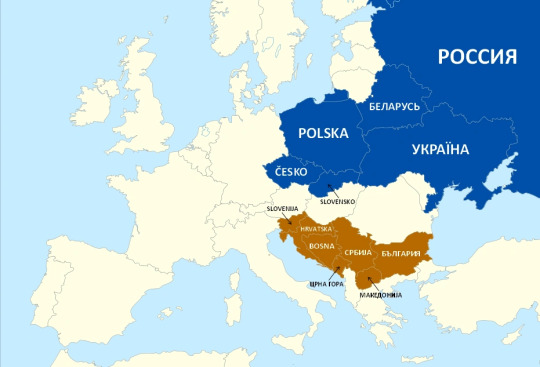
FInally, let's take a moment to talk about religion. Most Russians and Ukrainian are Orthodox Christians, aka “The Christianity people in the West forgets exists”. Short version is that before the Catholic Protestant Split in the 16th century, the previous sexy christian Split was in the 11th century between the Orthodox East and the Catholic West. Unlike the Reformation, this was less a doctrinal dispute and more of an organizational one, the Orthodox reject the Pope’s authority for the Byzantine Emperor, Catholics use latin as the liturgical language while the Orthodox used Greek, the Orthodox is a far more decentralized faith, they each have opposite signs of the cross, little things ike that. There have been…a lot of wars between these two groups and a lot of bad blood left over from said wars, such as the Fourth Crusade which sacked Constantinople or the Teutonic Knights (we will get to them more later.
Important for future events is the fate of the Byzantine Empire. Basically, when the Western Roman Empire Fell, the Eastern Empire continued on going until 1453, when it was finally destroyed by the Ottoman Empire. The Emperor was the head of the Orthodox church, so when the Empire fell, so too did the unity of the Orthodox church. Imagine if the Pope was killed, Rome was destroyed and no new pope was declared. So there isn’t one Orthodox CHurch, its several different Orthodox churches for each region.

#neglected historical fact#Ukraine#Russia#Orthidox Church#Borderlands#Natural Borders#russo ukrainian war#nationalism#“the Ukraine”#Campism#Tankies
4 notes
·
View notes
Note
I'm usually someone who doesn't put a lot of hate on writers since their writing is often puppeteered by others especially in the big 2 and even editorial... Si Spurrier is different tho. He's so full of himself and gets complimented left and right for doing bare minimum that he thinks he is exempted from criticism. He really needs a wake up call.
The fandom didn't lift a single finger tho and made it worse : There have been X-Men fans who complimented him for Margali's writing and looks. Yes, the dude who 1) turned her into the exact opposite of who she was and the worst she's ever been in all that is stereotyping since she joined an anti-mutant group for CASH, 2) didn't even draw her and, if he did have any hand in how she looked in his run, what does it mean for him to reveal her true form to just look like old Destiny aka a white woman when she's much younger than her by more than half a century and a Romani woman ?? and 3) used her as plot device to prop the Destiny and Mystique ship (canonically two white women from Austria) and rebuild the Darkholme family to be the only one Nightcrawler deserves and should have ever been part of since he went from being an abandoned child to a kidnapped one
X-Men fans somehow being racist is not surprising to me honestly. It's like someone needs to be so cartoonishly and obviously racist for them to realise it's racist.
2 notes
·
View notes
Note
I know the black triangle was used for roma, but it was used for homosexual women as well, yes?
The thing with the Nazi persecution of lesbians is that it's only been very recently researched by historians, the first major works about it date back from the 1990s. It's also a complicated subject to study because the Nazis never explicitly wrote lesbian persecution into the law the way they did for Jews, Roma, or gay men (the paragraph 175 on which they relied to send German gay men to camps date back from the 19th century iirc), so archival evidence is a bit hard to find. It's even more complicated because Nazis destroyed a lot of their documentation in 1945.
So far historians have found no lesbian deported to Auschwitz for the primary motive of her sexuality. When sexuality is mentioned on the entry register it is always as an addendum, never as a primary motive for their deportation. So the majority of the lesbians who were in Auschwitz had been arrested for belonging to another persecuted group (Jews, Roma, political opponents, etc), with their sexuality being an aggraviating factor.
In Ravensbrück, the women's Nazi concentration camp, there were 3 registered lesbians. Two of them were deported for political reasons (with “lesbian” as an addendum), so they wore the red triangle. One of them was deported for being “asocial”, so she had to wear the black triangle. That is the only example I know of a lesbian wearing the black triangle for her lesbianism.
That doesn't mean lesbians weren't persecuted by the Nazi regime; Nazis destroyed German lesbian culture, closed their bars and clubs, they prevented the publication of lesbian newspapers. They were forced to comply to Nazi sexist policies that wanted German women to marry German men and have children. Being a lesbian in a concentration camp also meant increased vulnerability. In Austria, where lesbianism was criminalized, lesbians were condemned, had to pay a fee, or were sent to Austrian prisons.
I really encourage you to read Claudia Schoppmann and Regis Schlagdenhauffen, because they both wrote very valuable stuff about Nazi lesbophobia.
In general, the black triangle was used to mark asocial prisoners, a very broad and vague category in which Nazis put anyone who didn't fit the other categories. It included Roma, prostitutes, beggars, alcoholics, etc. But Roma have a very distinct place among the rest of the "asocial" category, because it was applied to us not for social reasons but racial ones, because the number of Roma made to wear it far exceeds other "asocial" categories (proportionally speaking), because it was used to brand us for genocide and exterminatory policies, not just persecutory politics (as opposed to the other "asocial" categories), as in: entire families, newborns, the elderly, etc, had to wear it.
Though I am a bit tired of this discourse because the black triangle was not used everywhere, in every camp, or all throughout the Nazi period, frankly I would care less if this discourse wasn't always used as a pretext to minimize the Romani genocide, to negate the Romani genocide, to misrepresent Romani history and anti-Roma racism, etc. Like, the amount of time non-Roma spoke over us about the Romani genocide anytime this topic is brought up is so annoying😭.
Claudia Schoppmann, Nationalsozialistische Sexualpolitik und weibliche Homosexualität
Regis Schlagdenhauffen (ed.), Queer in Europe during the Second World War
Régis Schlagdenhauffen, « Les lesbiennes sont-elles des victimes du nazisme ? Analyse d'une controverse mémorielle », Revue d'Allemagne, tome 42, no 4, 2010
https://www.worldcat.org/fr/title/47812452
29 notes
·
View notes
Text

Ceija Stojka with her brother, Karl, and her partner, Horst Prügel
8 notes
·
View notes
Text
welcome!
this blog loves planet earth and the people in it.
some notes:
I generally try to identify places + groups
I try to make conscious decisions about tags that respect cultural identities, consider historical context and reject imperialism. I realize this is impossible and messy and doomed to be inconsistent. choices I've made include one Korea, one Ireland, and multiple tags for separatist states, i.e. Scotland, Catalan Countries.
I am currently unsure when or if it makes sense to tag the "bigger" nation in a post about an autonomous region, ex. China and Tibet, Faroe Islands and Denmark. I want to respect widespread independence movements, but also not become bloated with regional tags. Tibet deserves to be free of China but I have to laugh at modern Texas separatism.
Israel does not get a tag. Jewish diaspora, Free Palestine, genocide, USA, or anti imperialism are used.
I am not always sure when to use the indigenous peoples tag. if I am unsure I will probably leave it out.
except the history and prehistory tag, I currently am not tagging things that no longer exist, ex. Soviet Union, Roman Empire. I may instead tag with related tags, ex. Russia, Greece
Tags like EU, UK, Africa, Asia, Latin American, Polynesian, etc. are used in posts that refer to many places/groups collectively ex. Lunar New Year in Asia
I try to tag the country/group that an artist/writer/creator belongs to, ex. a post featuring Baldwin tagged with USA, literature, black diaspora
tags are ever-evolving!
country/place tags:
Africa, Albania, Angolia, Argentina, Armenia, Asia, Australia, Austria, Azerbaijan, Belarus, Belgium, Bhutan, Bosnia and Herzegovina, Botswana, Brazil, Bulgaria, Cameroon, Canada, Catalan Countries, Central African Republic, Chad, Chile, China, Colombia, Congo, Cuba, Czechia, Denmark, Dominican Republic, Emirates, Estonia, Ethiopia, EU, Faroe Islands, Finland, France, Germany, Greece, Greenland, Guatemala, Haiti, Hawai'i, Hungary, Iberia, Iceland, India, Iran, Ireland, Italy, Japan, Kazakhstan, Kenya, Korea, Kosovo, Kyrgyzstan, Latvia, Lithuania, Malaysia, Maldives, Mexico, Moldova, Mongolia, Montenegro, Mozambique, Namibia, New Zealand, Niger, Nigeria, North Macedonia, Norway, Pakistan, free Palestine, Panama, Paraguay, Peru, Philippines, Portugal, Puerto Rico, Qatar, Romania, Russia, Scotland, Serbia, Slovakia, Slovenia, Somalia, South Africa, South Sudan, Spain, Sri Lanka, Sudan, Sweden, Switzerland, Syria, Taiwan, Tajikistan, Tanzania, Thailand, free Tibet, Turkey, Uganda, Ukraine, USA, Uzbekistan, Vietnam, Wales, West Papau, Yemen, Zambia, Zimbabwe
diaspora + ethnic group + cultural group tags:
Ainu, Apache, Bahá'í, Basque, Black diaspora, Chechen, Choctaw, Chulym, Dakota, Dharumbal, Dolgan, Galician, Gavião, Guarani-Kaiowá, Hui, Igbo, immigrants, Ingorot, Inuit, Ixil, Jewish diaspora, Karakalpak, Kashmir, Kazakh, Ket, Khakas, Lakota, Latin American, Lezgin, Mah Meri, Maka, Makonda, Mari, Mohegan, Ojibwe, Pataxo, Polynesian, Pueblo peoples, Purepecha, Q'eqchi', Rapa Nui, Rohingya, Romani, Rukai, Ryukyuan, Sakapultek, Samburu, Sámi, Selkup, Sioux, Tamil, Tatar, Tigray, Tlingit, Tokalau, Uyghur, Yazidi
culture + other tags:
agriculture, airports, animals and wildlife, architecture, art, children, clothing and textiles, dance, ecology and environmentalism, festivals and holidays, film and tv, food, geopolitics, history, infrastructure, language, literature, maps, music, myth and legend, my posts, nature, prehistory, postcards and stamps, public transportation, religions and belief systems, solidarity, sports and games, traditions and customs, true spirit of the blog, urban landscape, water and boats, women
ugly tags:
acab, anti capitalism, anti imperialism, anti misogyny, anti xenophobia, genocide
2 notes
·
View notes
Text
It DOESNT MATTER if the Israelis' distant ancestors really came from Palestine
Leaving aside that "indigenous" in a political sense tends to mean "current victim of colonialism or post-colonial structures" and not "being originally from somewhere" (we don't usually call the French "indigenous") consider the following:
All Slavic people & their languages are thought to have originated in what is now Ukraine somewhere in the late middle ages and spread from there to everywhere they live today. Does that mean I can kick a Ukranian out of his house because I have a czech grandpa?
All the Bantu peoples are thought to have originated roughly in what is today Cameroon. Can any west or central African speaking a Bantu language kick out someone in Cameroon from their house? Or even a black person from the USA or the Caribbean?
All the Germanic Peoples originated from Jutland peninsula (what is today Denmark & some bits of Northern Germany.) - can a guy in England, Austria or the USA kick a Dane out of his house?
The people of Australia, Canada, the eastern USA & to a lesser extent South Africa (where many alre also descended from Netherlanders) are all descended from the English. Can they all come to England & kick an English farmer out of his house?
(they can, however, still in practice sometimes get an unfair advantage over Hawaiians & Puerto Ricans, or put a pipeline or mine through a Native American or Australian Aboriginal's home, or expropriate a black person to build a highway... at least there its not based on directly racist laws, in theory a rich POC could do it too.But in practice the result still often screws locals for short-sighted business ventures, so there is some stuff to be fixed still...)
The Romance languages all descend from Latin. Can any Italian kick ppl out out of everything that used to be Roman, including France, England and Bavaria?
Can any Greek kick someone out out of everything that used to be the Byzantine Empire?
Spain belonged to the Islamic empire for a long time. Can a Moroccan go kick a Spanish person out of his house?
Spain does give Spanish nationality to south american spaniards, (to attract skilled workers & fix low population growth), which I know cause my dad insisted on getting it due to patriotic feeling, but while he could buy a house there & vote, he cannot kick anyone out. Not even out of the exact village where his ancestors lived just 100 years ago.
Heck, the czech grandpa I mentioned? His family was expropriated when Communism took over. After communism, my mom & her siblings got an offer to get their farm/house back, but ONLY if they find the ppl currently living in the house an equivalent place.
It turns out there was a family of Romani ppl living there & it would be hard to find them a big house due to housing discrimination - my mom & her siblings just decided to let them keep the house since they were actually using it & none of us was planning to move to rural czechia. It seemed mean to kick out ppl who are being discriminated & had themselves lived there for decades now, after all we have our own places. (and my mom has, like, a painting of the town's church hanging in her living room & remembers living there as a little girl, & has stories about it, including some lewd jokes about the shape of the mountains.)
They should probably do a similar program in Palestine, where Palestinian families can get still-standing houses back or $$ for rebuilding destroyed villages, but the current inhabitants get provided for. Though probably the state should have to find them a new place, not impoverished Palestinians themselves. In the communist expropriation example, chances are the original owner was richer than the current one, which is different in Palestine.
Let us also consider the difference between conquest & immigration.
Conquest means you disrupt the social order & impose your own rules. This is clearly what was done in Palestine.
Immigration is different - I'm all for the right to immigrate & for ppl to live where they want, but immigrating means you fold yourself into an existing society & follow the laws there. (many ppl explicitly immigrate to places where they like the laws more)
The problem is not jewish ppl living in Palestine because they want to live in the land of their distant ancestors, but rather taking over & oppressing everyone else.
No one would mind my dad going to live in Spain where his ancestors lived. Indeed they would probably rejoice, he is a skilled worker & pays lots of tax. But if he came with an army, rebranded the country "new Cuba", demanded that everyone speak Latin American Spanish & started oppressing the local farmers, that would be a very different issue.
Though of course I wonder how many ppl care more about special treatment & free stuff than they do about religion or "connection to the land". Many might end up going to some gated community in the USA if they have to be equal citizens with no special privileges.
3 notes
·
View notes
Text

As I'm currently indexing this blog or, rather, meta-tagging posts in my new version of it on the Blogger website (I will post proper link as soon as it's finished), I decided to compile a list of all the women who feature (or receive a mention however fleetingly) within it. I have tried to trawl the blog ''with a fine toothcomb'', but I'm bound to have missed a few names - oh well! Here is the list as complete as I can muster. The women appear in (broadly) alphabetical order by first name. *** NB it is still a work in progress ***
VOCALISTS & MUSICIANS
Alice Waterhouse (flute) * Amy Winehouse * Angel Olsen * Annie June Callaghan * Ari Up & The Slits * Be Good Tanyas, The * Billie Holiday * Bjork * Black Belles, The * Cait O’ Riordan (Pogues) * Calista Williams (Bluebird) * Cindy Wilson & Kate Pierson (The B52s) * Cistem Failure * Clementine Douglas * Cosey Fanni Tutti * DakhaBrakha (well, 3/4 of them!) * Debbie Harry * Edith Piaf * Elizabeth Morris (Allo Darlin') * Holly Golightly * HoneyLuv * Katy-Jane Garside * Kelis * Kim Deal (Pixies & Breeders) * Maxine Peake * Maxine Venton & Mimi O'Malley (Captain Hotknives) * Meg White * Melanie Safka * Nico * Nina Simone * Patti Rothberg * Penny Ford (Snap!) * PJ Harvey * Rhoda Dakar (Special AKA) * Seamonsters, The * Siouxsie Sioux * Suzanne Vega * Tray Tronic * Trish Keenan (Broadcast)
VISUAL ARTS
Annegret Soltau * Anne Ophelia Dowden * Artemisia Gentileschi * Barbara Regina Dietzsch * Beverly Joubert * Camille Claudel * Clara Peeters * Dale DeArmond * Doreen Fletcher * Eleanor Fortescue-Brickdale * Élisabeth Sonrel * Elisabetta Siriani * Elizabeth Mary Watt * Ella Hawkins * Evelyn De Morgan * Frida Kahlo * Gertrude Abercrombie * Helen Martins * Kate Gough * Laura Knight (Dame) * Leonora Carrington * Lily Delissa Joseph * Liza Ferneyhough * Magdolna Ban * Mandy Payne* Mary Delany * Miina Akkijrkka * Ndidi Ekubia * Pamela Colman-Smith * Paula Rego * Rachel Gale * 'Romany Soup' * Sarah Vivien * Shirley Baker * Siirkka-Liisa Konttinen * Sofonisba Anguissola * Sonia Delaunay * Tish Murtha * Vali Myers * Vanessa Bell
COMEDY, DANCE & DRAMA
Alicia Eyo & Carol Morley ('Stalin My Neighbour') * Claire Foy * Daisy May Cooper * Gabrielle Creevy & Jo Hartley ('In My Skin') * Isadora Duncan * Jessica Williams ('Love Life') * Lesley Sharp, Michelle Holmes & Siobhan Finneran ('Rita, Sue & Bob Too') * Michaela Coel ('I May Destroy You') * Morgana Robinson * Samantha Morton * Yasmin Paige (Jordana Bevan in ‘Submarine)
WRITERS, JOURNALISTS, SCHOLARS & POETS
Agatha Christie (MBE) * Andrea Dunbar * Anaïs Nin * Angela Thirkell * Anna Funder * Anna Wickham * Edith Holden * Elizabeth O'Neill * Enid Blyton * Harriet Beecher Stowe * Helen Castor (Dr.) * Hilary Mantel * Janina Ramirez (Dr.) * Jeannette Kupfermann * Jenny March (Dr.) * Jenny Wormald (Dr.) * Lia Leendertz * Mary Oliver * Orna Guralnik (Dr.) * Rachel Beer * Susie Boniface * Virginia Woolf
HISTORICAL FIGURES
Anne, Queen of Great Britain * Anne Boleyn, Queen of England * Anne of Cleves, Queen of England * Boudicca, Queen of the Iceni * Cartimandua, Queen of the Brigantes * Catherine de’ Medici, Queen Consort/Regent of France * Catherine Parr, Queen of England * Catherine of Aragon, Queen of England * Catherine of Valois, Queen of England * Christine de Pizan * Cixi, Empress of China (aka Empress Tz'u-hsi ) * Eleanora of Austria, Queen of France * Eleanor of Aquitaine, Queen of France; Queen of England; Duchess of Aquitaine * Eleanor of Castile * Eleanor Talbot ("The Secret Queen") * Elizabeth I Queen of England * Elizabeth Woodville, Queen Consort of England * Elizabeth of York, Queen Consort of England * Elizabeth Stuart, Queen of Bohemia * Hatshepsut, Pharaoh of Egypt *Hildegard of Bingen * Isabeau of Bavaria, Queen of France * Isabella I, Queen of Castile * Isabella of Aragon, Princess of Asturias * Isabella of Portugal, Empress Consort of Holy Roman Empire and Queen Consort of Spain, Germany & Italy * Isabella of France, Queen of England * Jacquetta of Luxemburg * Jane Grey (Lady), Queen of England for Nine Days * Jane Seymour, Queen of England * Juana (aka Joanna), Queen of Castile * Katherine Howard, Queen of England * Louise of Savoy, Regent of France * Margaret of Anjou, Queen Consort of England * Margaret of Austria [check which one] * Margaret Beaufort, Lady * Marie Antoinette, Queen of France * Mary I, Queen of England * Mary II, Queen of England, Scotland & Ireland * Mary, Queen of Scots * Mary of Austria [check which one] * Mary of Burgundy, Duchess * Matilda, Holy Roman Empress * Melisende, Queen of Jerusalem * Sophia of Hanover, Electress * Tatya Betul, Empress of Ethiopia * Theodora, Empress of Byzantium * Victoria, Queen of England & Empress of India
SAINTS & BIBLICAL/CHRISTIAN REFERENCES
Anna (wife of Tobit) * Apollonia (Saint) * Barbara (Saint) * Catherine of Alexandria (Saint) * Ecclesia * Eve (the first woman) * Felicitas of Rome (Saint) * Genevieve (Saint) * Godeberta * Jael * Jezebel * Judith * Lucy (Saint) * Margaret of Scotland (Saint) * Mary Magdalene * Rahab * Rose of Lima (Saint) * Synagoga * The Queen of Sheba * Thérèse of Lisieux (Saint) * Virgin Mary, The* "Whore of Babylon", The * Ursula (Saint)
MYTHOLOGICAL
Anat * Asherah * Astarte * Atalanta * Aurora * Baba Yaga * Circe * Chhinnamasta * Clio/Kleio * Demeter (Rmn: Ceres) * Dido, Queen of Carthage * Durga * Elaine of Astolat * Europa * Eurydice * Hathor * Hesperides * Io * Isolde/Iseult * Isis * Juno (Gk: Hera) * Kali * Kriemhild/Gudrun * Kudshu * Lakshmi * Persephone (Rmn: Proserpine) * Radha * Sabine Women, The * Sati * Sedna * Sirens, The (half-female, half-bird) * Three Graces, The * Valkyries, The * Venus (Aphrodite)
WIVES, MUSES, CONSORTS & SIGNIFICANT OTHERS
Anastasia Romanovna (wife of Ivan the Terrible) * Anne Hyde (1st wife of James, Duke of York; she did not live long enough to see him become James II) * Anne Lovell (wife of Sir Francis Lovell) * Anne of Denmark (wife of James VI of Scotland/James I of England & Ireland) * Bella Chagall (wife of Marc Chagall) * Catherine of Braganza (wife of Charles II) * Charlotte of Mecklenburg-Strelitz (Queen of England as wife of George III) * Clementine Churchill (wife of Winston Churchill) * Diane de Poitiers (royal mistress to the French king, Henry II) * Emma Hamilton, Lady (mistress of Lord Horatio Nelson) * Evelyn Pyke-Nott (wife of John Byam Shaw) * Françoise Gilot (partner of Pablo Picasso) * Frances Grey, Duchess of Suffolk (mother of Lady Jane Grey) * Henrietta-Maria (wife of Charles I) * Lady Martha Temple (wife of Sir William Temple) * MacDonald sisters, The (Alice, Georgiana, Agnes and Louisa) * Marguerite of Navarre/Angoulême (sister of French king, Francis I) * Mary of Modena (2nd wife of James VI and I, King of Scotland, England, and Ireland) * Mary Shelley (mentioned as wife of Percy Bysshe Shelley, though a renowned author in her own right) * Mary Soames (daughter of Winston Churchill & wife of Christopher Soames) * Mary Stuart (daughter of Charles I and mother of the future William III) * Mary Watts (wife of George Frederic Watts, and designer and artist in her own right) * Olga Khokhlova (1st wife of Pablo Picasso) * Portia (wife of Brutus) *
2OTH CENTURY & MODERN DAY
Christabel Pankhurst * Emily Wilding Davison * Emmeline Pankhurst * 'Gulabi Gang' * Hannah Hauxwell * Helen Keller * Hilary Clinton * Liz Truss * Margaret Campbell, Duchess of Argyll * Mata Hari * Melina Mercouri * Nazanin Zaghari-Ratcliffe * Rahima Mahmut * Sylvia Pankhurst *
8 notes
·
View notes
Text
Deutschribing Germany
Languages
Most languages native to Germany belong to the Germanic family, but some of them are Slavic languages. German is the official language, with over 95% of the country speaking Standard German or one of its dialects as their first language.
There are six recognized minority languages: Danish, Lower Sorbian, North Frisian, Romani, Saterland Frisian, and Upper Sorbian. The main immigrant languages spoken are Arabic, Dutch, Greek, Italian, Kurdish, Polish, Russian, Serbo-Croatian, Tamil, Turkish, and Ukrainian.
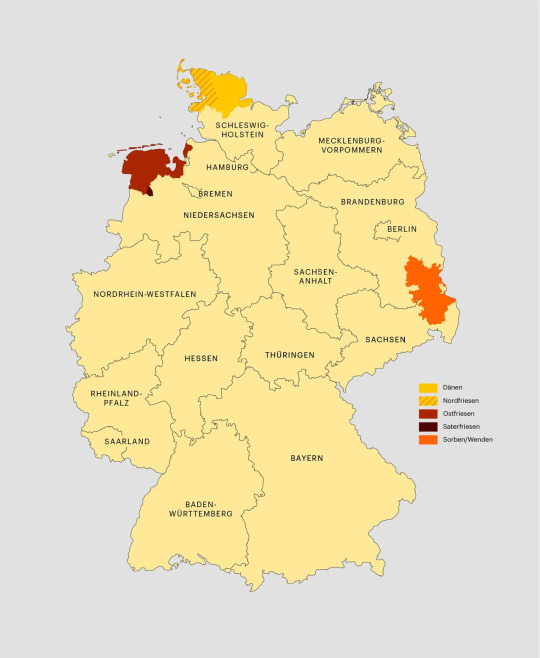
German (Deutsch)
German belongs to the West Germanic group of languages and is the native language of 95 million people. It is the official language in Austria, Belgium, Germany, Liechtenstein, Luxembourg, and Switzerland, as well as South Tyrol in Italy, and is a recognized minority language in ten countries from four different continents.
German Standard German is the standardized variety of German spoken in Germany. Its pronunciation is similar to the German spoken in Hanover. Its alphabet has 30 letters: a b c d e f g h i j k l m n o p q r s t u v w x y z ä ö ü ß. Most German vocabulary is of Germanic origin, but around one fifth was taken from French or Latin. German dialects and varieties are explained in detail in this post.
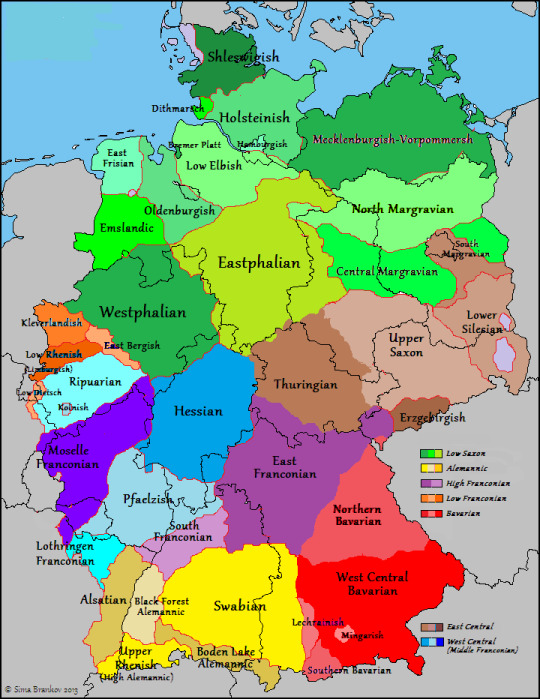
Romani (rromani ćhib)
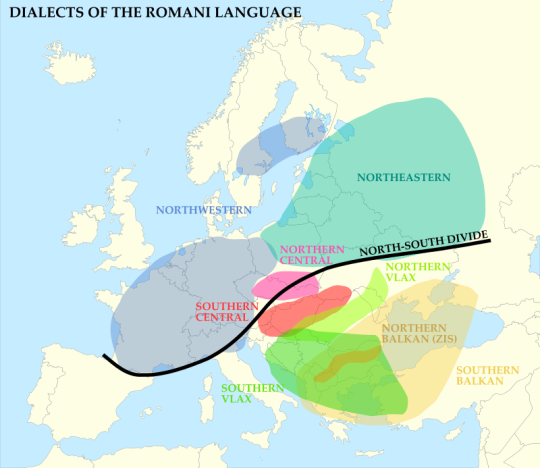
Sinte Romani (sintitikes) is the variety of Romani spoken in Germany and neighboring countries. It belongs to the Northwestern Romani dialect group, which in turn is part of the Indo-Iranian branch of the Indo-European family. It is spoken by around 195,000 people and is not mutually intelligible with other Romani varieties.
There is no standard pronunciation or grammar. The alphabet has 31 letters: a b c č čh d dž e f g h i j k kh l m n o p ph r s š t th u v x z ž.
Danish (dansk)
Danish is a North Germanic language with 6 million native speakers. It is the official language of Denmark and the Faroe Islands and a recognized minority language in Schleswig-Holstein and Greenland.
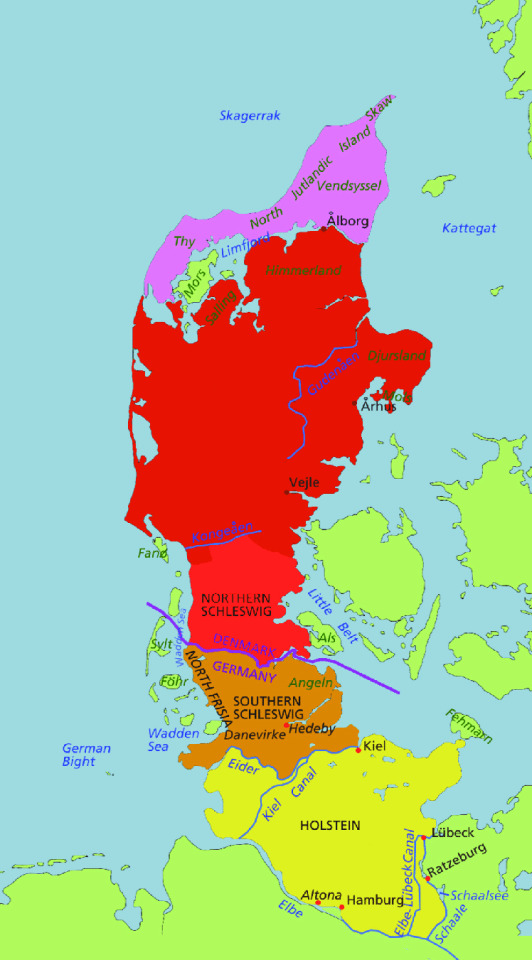
The Danish alphabet has 29 letters, including the 26 found in the English one and æ, ø, and å.
Upper Sorbian (hornjoserbšćina)
Upper Sorbian (Obersorbische Dialekte in the map) belongs to the West Slavic branch and is recognized as a minority language in Saxony, where its 13,000 native speakers live.
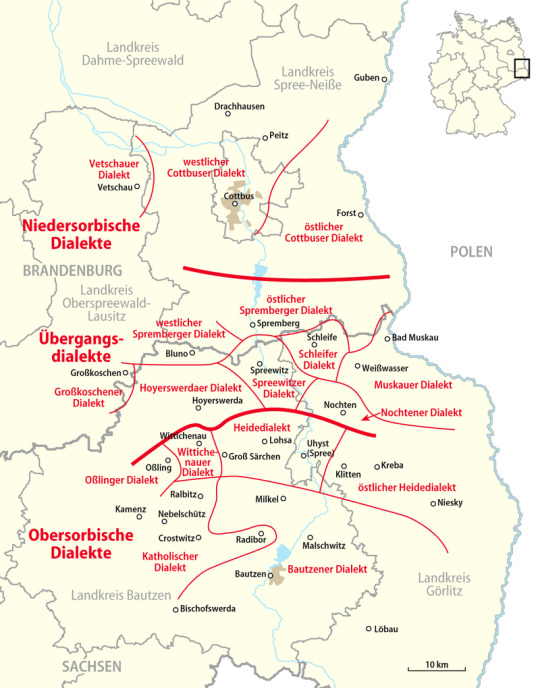
Its alphabet has 34 letters: a b c č ć d dź e ě f g h ch i j k ł l m n ń o ó p r ř s š t u w y z ž.
North Frisian (Nordfriisk)
North Frisian is part of the West Germanic branch and is spoken natively by 10,000 people in Schleswig-Holstein. It comprises 10 dialects, which are divided into two groups: insular and mainland.
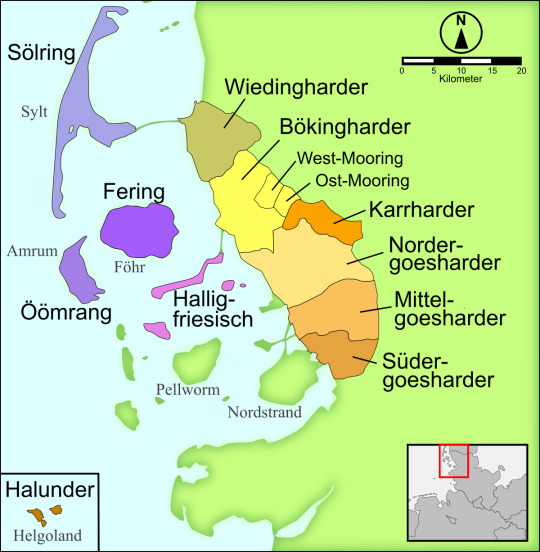
Its phonology and orthography vary depending on the dialect, but there are 32 basic letters: a ä å b ch d dj đ/ð e f g h i j k l lj m n ng nj o ö p r s sch t tj u ü w.
Lower Sorbian (dolnoserbšćina)
Lower Sorbian (Niedersorbische Dialekte in the map of Sorbian dialects) is a West Slavic language spoken natively by 6,900 people in Brandenburg.
It uses the same letters as Upper Sorbian but adds��ś and ź and uses ŕ instead of ř, bringing the total number of letters to 36.
Saterland Frisian (Seeltersk)
Saterland Frisian belongs to the West Germanic branch and is recognized as a minority language in Lower Saxony. It is spoken by 2,200 people and has three fully mutually intelligible dialects.
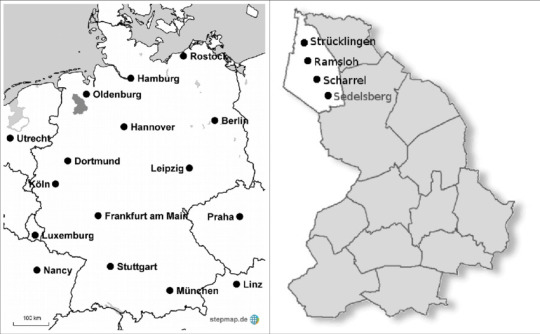
Its orthography has not been standardized yet, but there are 31 common letters: a ä b ch d e f g h i ie j k/kk ks kw l m n ng o oa ö p r s sch t u ü v w.
Here is Article 1 of the Universal Declaration of Human Rights in the native languages of Germany:
German: Alle Menschen sind frei und gleich an Würde und Rechten geboren. Sie sind mit Vernunft und Gewissen begabt und sollen einander im Geist der Brüderlichkeit begegnen.
Romani: Sa e manušikane strukture bijandžona tromane thaj jekhutne ko digniteti thaj capipa. Von si baxtarde em barvale gndaja thaj godžaja thaj trubun jekh avereja te kherjakeren ko vodži pralipaja.
Danish: Alle mennesker er født frie og lige i værdighed og rettigheder. De er udstyret med fornuft og samvittighed, og de bør handle mod hverandre i en broderskabets ånd.
Upper Sorbian: Wšitcy čłowjekojo su wot naroda swobodni a su jenacy po dostojnosći a prawach. Woni su z rozumom a swědomjom wobdarjeni a maja mjezsobu w duchu bratrowstwa wobchadźeć.
North Frisian: Ali Mensken sen frii, likwērtig en me disalev Rochten bēren. Ja haa Forstant en Giweeten mefingen en skul arküđer üs Bröđern öntöögentreer. (Sylt/Sölring dialect)
Lower Sorbian: Wšykne luźe su lichotne roźone a jadnake po dostojnosći a pšawach. Woni maju rozym a wědobnosć a maju ze sobu w duchu bratšojstwa wobchadaś.
Saterland Frisian: Aal do Moanskene sunt fräi un gliek in Wöide un Gjuchte gebooren. Joo hääbe Fernunft un Gewieten meekriegen un schällen sik eenuur as Bruure ferhoolde. (Ramsloh dialect)
Translation: All human beings are born free and equal in dignity and rights. They are endowed with reason and conscience and should act towards one another in a spirit of brotherhood.
5 notes
·
View notes